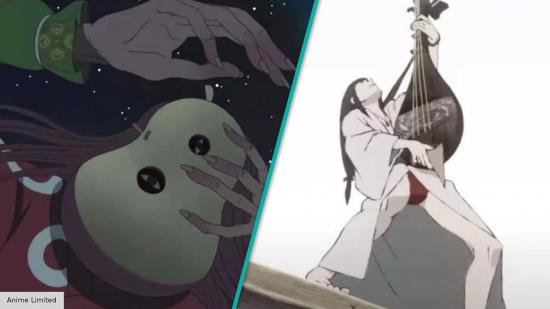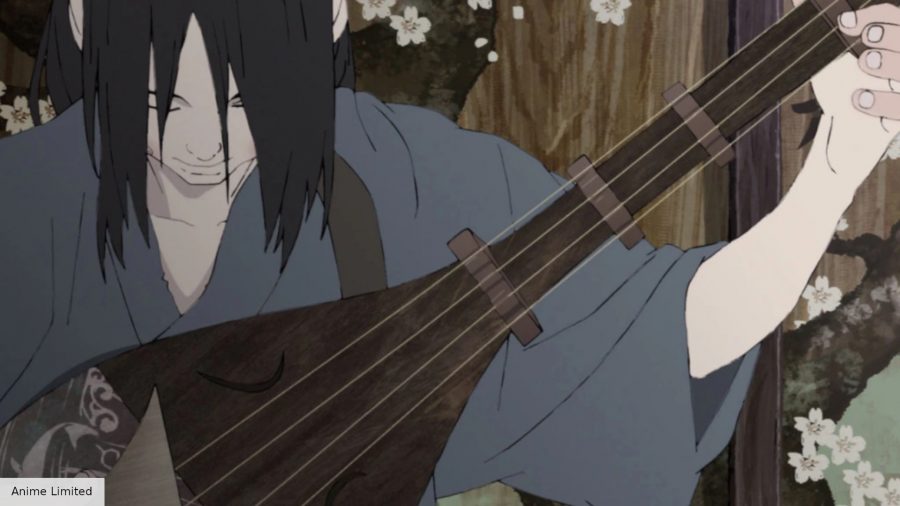Our Verdict
Masaaki Yuasa creates a rollicking blend of rock and roll and Japanese history
There’s a quote often-attributed to Freddie Mercury: “I won’t be a rockstar, I will be a legend.” The internet has made finding the original source of this line difficult. However, hard evidence is secondary to the way these words capture the essence of the Queen frontman, and contribute to keeping his legacy alive.
Inu-Oh, an anime movie rock opera, is all about the importance of myth in our collective memory. What starts as a recounting of conflict in feudal Japan becomes an audacious, riff-driven adage to rebellion, where two unlikely heroes, Inu-Oh the cursed dancer and Tomona the blind biwa player, go on to define a generation.
Their rise to prominence is charted by Masaaki Yuasa, a director who, from experimental anthology Mind Game through to nihilistic anime series Devilman CryBaby, has made a habit of disobeying convention throughout his career. This might be his most well-rounded production to date, a joyful tribute to headbanging, history, and combining the two in explosive stage shows.
We’re greeted by a dense prelude to start, with narration doing its level best to summarise prolonged disputes between the Genji and Heike clans in the 1100s, before jumping forward two centuries. Genji pushed Heiki to the fringes, and several artefacts imbued with sacred power are presumed lost. Tomona’s father is convinced one lays just off the coast of their oceanside home, and when he’s proven right, kills himself, and blinds his son by fiddling with the object.
Elsewhere, a cursed mask appears to cause a woman to give birth to a disfigured child. Masaaki bases his adaptation on the 2017 novel Tales of the Heike: Inu-Oh, written for the screen by Akiko Nogi and once the story steps out of this preamble, it quickly finds itself. In an effort to honour his lineage by spreading the word of the Heike, Tomona begins travelling by foot, his sightless footsteps depicted in gorgeous sketched outlines. He stumbles upon an old biwa player who takes the child under his wing.
Into his teen years, Tomona becomes a great player, frequently performing around the region. Inu-Oh may begin as a historical epic, but in practice, it’s closer to a musical biopic, focusing on the discipline and craftsmanship that begets future greatness, as well as all the serendipity. During a stay in ancient Kyoto, Tomona runs into Inu-Oh, an eccentric, masked vagrant with a contorted body who’s obsessed with dancing.
They bond over a shared spirituality and love of performance, and they find that when Inu-Oh moves to Tomona’s playing, his limbs grow back to regular size. He’d been ostracised by local schools of Noh, a traditional but highly regimented form of dance, and Tomona is the conduit by which he can sincerely express himself.
Other worlds: The best animated movies
It isn’t long before they’ve got themselves a band, and host their first gig, busking on a crowded bridge. There are worse venues to make your debut, as evidenced by the size of the audience who lap up the distorted playing and long-haired swagger. Not that we’ve entered an alternate past where Marshall was producing amps 800 years ago; this is the point where Masaaki formalises the crossover between classic fable and metal iconography.
The pomposity and allure of sweaty rock is used to explain the sheer electricity between Tomona and Inu-Oh, and what it must’ve been like to share in their work. Even if nobody using the Biwa quite had Tony Iommi’s sense of low end melody, there were almost certainly some equivalents whose breaking away from the hegemonic orders of the era caused excitement and consternation in equal measure.
They aren’t playing on idle walkways for too long – soon, they’ve got enough production value to make Kiss jealous. Science SARU, a studio co-founded by Masaaki, captures the revelry and bombast as good as any professionally shot live concert. Gigantic, wooden arenas can barely hold the spectacle, muscular licks blasting into the air as the mystifying frontman Inu-Oh commands onlookers. There’s a line to be drawn between him and Mercury, as bright-burning, enigmatic stars who found themselves in front of adoring crowds.

Something Inu-Oh does considerably better than 2018’s Bohemian Rhapsody is show us what being on-stage can do to someone who’s been ostracised or feels aimless. Inu-Oh is transformed from someone people couldn’t bear to look at into the object of their desires through the power of creative expression. Likewise, Tomona finds renewed purpose in being a conduit for it all, not least in the way their touring defies Genji leadership.
An undercurrent for Tomona is the risk of assimilation. When he agrees to change his name, his dad’s spirit tells him he’ll be harder to track down by his ancestors. In the realm of Inu-Oh, connections with our roots are tangible and require maintenance if we want to keep them. Masaaki extends the viewpoint that we honour the dead the same way we keep our favourite albums: by finding time to listen to them.
It takes all sorts: The best animated series
Like any great musical quest, Inu-Oh and Tomona’s ends in grand fashion. Their voyage is bookended by modern-day sequences, bringing us back to the here and now. If it wasn’t for a bumpy introduction, this would be the stuff of dreams. You can feel shades of certain contemporaries, like the pensive The Deer King, and the loud spectacle of Mamoru Hosoda’s Belle, but once again, Masaaki stands alone.

